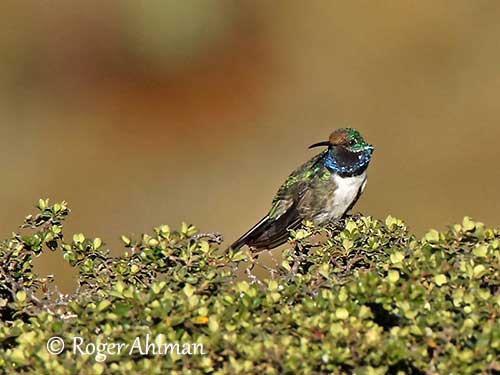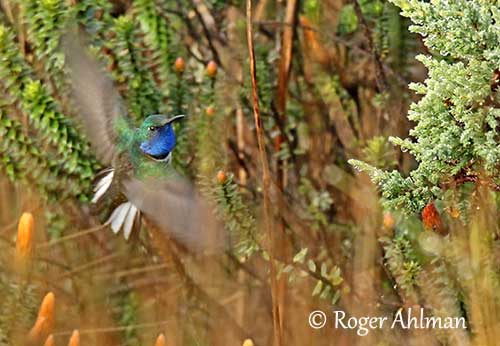
Fr: Colibri d'El Oro
Ang: Blue-throated Hillstar
Esp: Estrella de Garganta Azul
Nd: Blauwkeelbergnimf
Sd: blåstrupig bergstjärna
Photographer:
Roger Ahlman
Pbase Galleries Peru and Ecuador
Text by Nicole Bouglouan
Sources:
HANDBOOK OF THE BIRDS OF THE WORLD Vol 5 by Josep del Hoyo-Andrew Elliott-Jordi Sargatal - Lynx Edicions - ISBN: 8487334253
Mongabay - This blue-throated hummingbird is new to science, but already endangered
American Bird Conservancy
New species of hummingbird identified in Ecuador
SCI-NEWS - New Hummingbird Species Discovered in Ecuador
Wikipedia, the free encyclopaedia
Blue-throated Hillstar
Oreotrochilus cyanolaemus
Apodiformes Order – Trochilidae Family
INTRODUCTION:
The Blue-throated Hillstar is a recently discovered hummingbird. It was found in April 2017 in the Ecuadorian Andes at high elevation.
It usually frequents bush-lined creeks, and its habitat is only about 114 km².
This species described in September 2018 is especially adapted to cold temperatures. Like other hillstars of this group, it spends at least half its life in hypothermic torpor, because it is living in a cold, oxygen-reduced environment.
It feeds on nectar from flowers, and especially Asteraceae, but other plant species are also visited. The breeding behaviour is currently unknown.
The Blue-throated Hillstar is a restricted-range species, threatened by mining activity, pine-tree plantations and pastureland expansion, involving habitat loss. Conservation actions are needed to protect the small area where this bird is living.
The Blue-throated Hillstar is currently listed as Critically Endangered.
DESCRIPTION OF THE BIRD:
Biometrics:
Length: 11-12 cm
The Blue-throated Hillstar adult male shows the characteristic glittering ultramarine blue throat, typical of hillstar males. The head is iridescent emerald green and the blue-green reflections extend down to back and shoulders.
On the upperwing, flight-feathers and greater coverts are dull blackish with weak blue sheen. The outermost primaries show narrow whitish edges. On the uppertail, the coverts are emerald blue-green while the central rectrices are mostly blackish-blue to blue-green.

On the underparts, the triangular blue throat is underlined by a contrasting black collar separating the iridescent blue feathers from the white underparts. There is a vertical black stripe extending from mid-belly to breast. Breast sides and flanks are greenish-grey. On the undertail, the central rectrices are blackish-blue, whereas the outer rectrices are white with blackish tips of variable size.
The black bill is fairly long and slightly downcurved. The eyes are dark brown with a small white spot on the rear corner. Legs and long toes are black.
The Blue-throated Hillstar adult female has more bronze-green than emerald green head, shoulders and back. The forehead is duskier. On the uppertail, the coverts are blue and brighter than the upperparts, with metallic-blue-green sheen on central rectrices. On the upperwing, flight-feathers and greater coverts are dusky with some bluish sheen, and the outermost primaries are narrowly fringed whitish.
The female lacks the blue colour on the throat. Chin and throat are dull white with green spots on the sides and dusky spots on the chin and centre of throat. Rest of underparts is dull greyish-buff with some brighter olive-green feathers on flanks. On the undertail, rectrices are bluish-green with white bases in all feathers except central air.
The juvenile resembles adult female but with much duller plumage. The base of the lower mandible and the mouth are pale orange.
RANGE:
The Blue-throated Hillstar is restricted to some mountain tops in Loja and El Oro provinces in S Ecuador. The range is about 114 km² and is restricted by Jubones-León river valley to N and NE, and by Puyango-Catamayo drainage basin to South.

HABITAT:
The Blue-throated Hillstar is found in páramo, a unique ecosystem of boggy grass and shrubland with scattered evergreen plants, mosses and cacti. This species is living in a cold, oxygen-reduced environment.
It occurs at high elevations, between 3,300 and 3,700 metres, in rocky outcrops or around creeks on gentle slopes, but also in hilly terrain or steep-sided hills.
CALLS AND SONGS:
The species of genus Oreotrochilus gives territorial songs, given by both adults, including rapid twitters with raising and falling notes interspersed by rattles. They also produce a variety of notes, highly variable in composition.
Both adults often give a short, single note call composed of an up-and-down stroke, with most volume on the upstroke.
BEHAVIOUR IN THE WILD:
The Blue-throated Hillstar feeds on nectar from flowering plants, and especially Chuquiraga jussieui in the family Asteraceae, native from Ecuador and Peru. This plant is called “national flower of Andean mountain climbers” and the “flower of true love”. It is the main food of this hillstar which is the main pollinator of the plant. But the Blue-throated Hillstar also feeds on nectar from Ericaeae plant species.
It is often chased away by dominant species around good food sources.

Due to the oxygen-reduced environment, this species is less reliant on flight than other Trochilidae. It feeds mainly by clinging sideways or upside down to the plant, or also perches close to the flower. The large feet of this hummingbird are well adapted to this feeding behaviour. It may consume up to double its weight in nectar! It also performs short aerial sallies to snap up flies (Diptera).
However, degradation of this habitat involves the disappearance of the Chuquiraga jussieui across the mountain range of this species. Restoration of this habitat type is a key to protect this hummingbird.
The Blue-throated Hillstar often perches on rocks covered in lichens or on boulders, usually close to the ground or small streams. At night, it enters a state of hibernation or torpor, during which the high metabolism slows and the heart rate drops. The heart of these birds beats 1,600 times per minute during the day, but it goes down to 200 at night. This state allows them to survive in their cold environment and mainly during the night.
The breeding behaviour of this species is currently unknown.
The Blue-throated Hillstar is resident and no altitudinal movements have been recorded.
It only flies between the flowering plants when feeding, and it hovers less than other hummingbirds. It probably performs only short distance flights.

REPRODUCTION OF THIS SPECIES:
This behaviour is unknown. However, in this group of birds living in high mountains, the colours of the plumage play a role in social behaviour, and especially the bright colour of the throat that acts as a social signal allowing or deterring the reproduction.
The “Andean clade” includes five sub-units. The genus Oreotrochilus is in the second one among other genera. These birds have some common behaviours such as open wing presentations after perching; distress calls; perching displays; advertisement songs; plumage characteristic; nest shape and nest-site.
The nest of these mountain hummingbirds are usually bulky, made with moss and lichens held together with spider webs. The nest is often placed in sheltered site, under tussocks or against rocks. This type of nest attempts to control the hard weather conditions as it is built with a sunny exposure and sheltered from the wind.
In hillstars, the territorial roles are usually reversed and the territory is defended by the female.

PROTECTION / THREATS / STATUS:
The Blue-throated Hillstar has very restricted range (114 km²) at high elevation in the Andes of Ecuador.
This species is disappearing quickly because its habitat is converted in pine-tree plantations and pastureland. In addition, this area lies within mining concessions for gold and other various metals. Actually, this habitat is being lost to human activity.
It is necessary to protect this area, and researchers are now working to protect both the birds and their habitat, with help of local communities.
The population is roughly estimated at 250/750 individuals, but possibly less than 500 individuals.
The Blue-throated Hillstar is currently listed as Critically Endangered.
